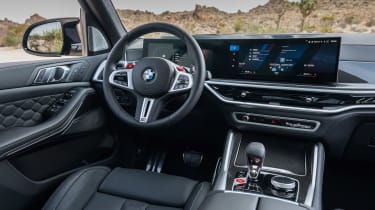Updated 2023 BMW X5 M Competition revealed with X6 M twin
BMW M’s original SUVs have been tweaked to keep up with Porsche’s Cayenne Turbo GT
BMW has revealed updated versions of the X5 and X6 M Competitions featuring all-new interiors, sharper exterior styling, and a host of subtle mechanical updates. Both models are available to order now, and will cost from £123,350 for the X5 and £126,050 for the X6 when they arrive in the UK in the next few months.
Mechanically, the pair keep hold of their twin-turbocharged 4.4-litre V8 engines, but now receive mild hybrid assistance that runs a small integrated starter motor and generator in the transmission housing on a stand-alone 48V electrical system. BMW M has mounted this secondary electrical system’s battery pack under the bonnet so as not to impact on cabin space, where it will help reduce load on the engine and offer a subtle kick from the electric motor under hard acceleration.
The engine itself has also picked up a collection of small detail upgrades including a redesigned cross-bank exhaust manifold, a reinforced crankshaft, minor changes to the internals of the turbochargers themselves, a redesigned oil sump and new oil pump. There’s also new catalytic converters in the exhaust system.
Peak power and torque remain unchanged to the previous model, but are still right at the apex of the class with 616bhp generated at 6000rpm, paired with 553lb ft of torque that holds its peak from 1800rpm all the way to 5800rpm. This spread of torque helps the pair feel even faster than their figures suggest, reaching 62mph in 3.9sec and 124mph in 13.8sec (the marginally more aerodynamic X6 drops this secondary figure to 13.6sec). Top speed is limited at 155mph, but can be raised to 180mph with the optional M Driver’s Package.
Helping put all this power to the ground is the usual BMW M xDrive system, which comes with two selectable torque splits that both have a heavy rear-drive bias. Unlike many of its equivalent rivals, both X5 and X6 M Competitions also utilise an electronically-controlled limited-slip differential to manage wheelspin on the rear axle, as well as mechanically apportion power to one of the individual rear wheels.
The transmission is BMW’s usual eight-speed automatic transmission, but has its own selection of refinements including new ratios, a new oil sump, redesigned internal hydraulics and active mounts. BMW M says these changes make the transmission even more responsive, and reduce the speed of the actual shifts.
Where the X5 and X6 M Competition differ from most of its large high performance SUV rivals is the suspension, where BMW M has employed a combination of coil springs on adaptive dampers combined with an active anti-roll system. Most SUVs of this size generally utilise air-springs, but reverting to steel coils is a hardware choice that’s slowly becoming more common, a recent example being Lamborghini utilising a coil-sprung system in its new Urus Performante. The general setup is still double-wishbone at the front with a five-link rear, but there’s new values to toe-in at the rear and the dampers have been recalibrated, too.
The chassis itself is also significantly overhauled in comparison to the standard X5 and X6, with stiffening elements including strut braces above and a shear plate below the engine, lateral struts at the rear and a new tunnel bridge around the exhaust. The electric power steering and integrated braking systems have also been fiddled with, the latter controlling the same set of 395mm front and 308mm rear steel discs. The wheels are staggered 21- and 22-inch diameter, with 295-section front and 315-section rear Michelin rubber fitted from the factory. How much does all of this weigh? BMW M has yet to reveal an official kerb weight, but the current X5 M comes in at 2410kg.
The rest of the changes are more superficial, with new exterior styling based on the standard X6 – both the X5 and X6 M Competition now share the same front-end design. Inside, the cabin’s been totally overhauled in BMW’s latest style, which is dominated by a curved touchscreen display, and the available colour and trim options have also been tweaked to include BMW’s latest hues.
These should help keep the pair fresh in comparison to most of its main rivals that include everything from Audi’s RSQ8 to the Porsche Cayenne Turbo GT and Lamborghini Urus Performante – all of which have recently gone through, or are about to go through their own mid-cycle updates.











